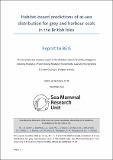Habitat-based predictions of at-sea distribution for grey and harbour seals in the British Isles : Report to BEIS, OESEA-16-76, OESEA-17-78
View/
Date
27/11/2020Author
Funder
Grant ID
NE/R015007/1
Keywords
Metadata
Show full item recordAbstract
The United Kingdom has large populations of both grey (Halichoerus grypus) and harbour seals (Phoca vitulina), which are protected under national and international legislation. In recent years, aerial surveys have revealed region-specific changes in population dynamics for both species, ranging from exponential increases (e.g. grey seals in the Southern North Sea) to catastrophic localised declines (e.g. harbour seals in East Scotland and Orkney). Up-to-date information on the at-sea distributions of these species is required to inform environmentally sensitive management strategies and marine spatial planning. Such distributions have been estimated using data from animal-borne telemetry tags which record and transmit tracking data, providing information on at-sea movements and haul-out behaviour. Such tags are glued to the seal’s fur and fall off during the annual moult. The Department for Business, Energy and Industrial Strategy, through their Offshore Energy Strategic Environmental Assessment (OESEA) programme, provided funding for a large-scale deployment of high resolution GPS telemetry tags on grey seals around the UK, and the subsequent analyses to generate up-to-date estimates of at-sea distribution for both seal species. To produce these estimates, a habitat modelling approach was adopted; seal tracking data were matched to a sample of the available habitat to quantify the region-specific species-environment relationships underpinning seal distribution. Spatially resolved abundance data (i.e. haulout counts) were then used to generate predictions for both species emanating from all known haulouts in the British Isles. The resulting predicted distribution maps provide estimates per species, on a 5 km x 5 km grid, of relative at-sea density for seals hauling-out in the British Isles. Three values are given for each grid cell: the mean density prediction from the habitat preference models and associated lower and upper 95% confidence intervals. For each cell, the confidence intervals provide a range of values in which, according to the models, the true seal density is likely encompassed. The mean provides a measure of the centre of this range. Appendices to this report present some additional analyses, including an example of a potential application of the predicted distribution maps by means of a case study estimating the number of grey and harbour seals using areas of interest, specifically windfarm lease areas and tidal energy development sites in the UK sector. Moreover, analysis of recent tracking data has revealed further evidence that seals use man-made structures for foraging, and potentially navigation, especially in the North Sea where structure density is highest. Lastly, additional analyses reveal movements of female grey seals between foraging grounds in the Hebrides and breeding sites in North Scotland, providing further evidence that regional population dynamics may be affected by foraging conditions elsewhere.
Citation
Carter , M I D , Boehme , L , Duck , C D , Grecian , J , Hastie , G D , McConnell , B J , Miller , D L , Morris , C , Moss , S , Thompson , D , Thompson , P & Russell , D JF 2020 , Habitat-based predictions of at-sea distribution for grey and harbour seals in the British Isles : Report to BEIS, OESEA-16-76, OESEA-17-78 . Sea Mammal Research Unit, University of St Andrews .
Type
Report
Collections
Items in the St Andrews Research Repository are protected by copyright, with all rights reserved, unless otherwise indicated.

